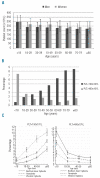Analysis of 12,517 inhabitants of a Sardinian geographic isolate reveals that predispositions to thrombocytopenia and thrombocytosis are inherited traits
- PMID: 20823129
- PMCID: PMC3012770
- DOI: 10.3324/haematol.2010.029934
Analysis of 12,517 inhabitants of a Sardinian geographic isolate reveals that predispositions to thrombocytopenia and thrombocytosis are inherited traits
Abstract
Background: Thrombocytopenia is a common finding in several diseases but almost nothing is known about the prevalence of thrombocytopenia in the general population. We examined the prevalence of thrombocytopenia and determinants of platelet count in a healthy population with a wide age range.
Design and methods: We performed a cross-sectional study on 12,517 inhabitants of ten villages (80% of residents) in a secluded area of Sardinia (Ogliastra). Participants underwent a complete blood count evaluation and a structured questionnaire, used to collect epidemiological data.
Results: We observed a platelet count lower than 150 × 10⁹/L in 3.2% (2.8%-3.6%) of females and 4.8% (4.3%-5.4%) of males, with a value of 3.9% (3.6%-4.3%) in the entire population. Thrombocytopenia was mild (platelet count: 100 × 10⁹/L-150 × 10⁹/L), asymptomatic and not associated with other cytopenias or overt disorders in most cases. Its standardized prevalence was quite different in different villages, with values ranging from 1.5% to 6.8%, and was negatively correlated with the prevalence of a mild form of thrombocytosis, which ranged from 0.9% to 4.5%. Analysis of platelet counts across classes of age revealed that platelet number decreased progressively with aging. As a consequence, thrombocytopenia was nearly absent in young people and its prevalence increased regularly during lifetime. The opposite occurred for thrombocytosis.
Conclusions: Given the high genetic differentiation among Ogliastra villages with "high" and "low" platelet counts and the substantial heritability of this quantitative trait (54%), we concluded that the propensity to present mild and transient thrombocytosis in youth and to acquire mild thrombocytopenia during aging are new genetic traits.
Figures



Comment in
-
Determinants of platelet count in humans.Haematologica. 2011 Jan;96(1):10-3. doi: 10.3324/haematol.2010.035287. Haematologica. 2011. PMID: 21193429 Free PMC article. No abstract available.
References
-
- Crowther MA, Cook DJ, Meade MO, Griffith LE, Guyatt GH, Arnold DM, et al. Thrombocytopenia in medical-surgical critically ill patients: prevalence, incidence, and risk factors. J Crit Care. 2005;20(4):348–53. - PubMed
-
- Fernández M, Alarcón GS, Apte M, Andrade RM, Vilá LM, Reveille JD LUMINA Study Group. Systemic lupus erythematosus in a multiethnic US cohort: XLIII. The significance of thrombocytopenia as a prognostic factor. Arthritis Rheum. 2007;56 (2):614–21. - PubMed
-
- Mientjes GH, van Ameijden EJ, Mulder JW, van den Hoek JA, Coutinho RA, von dem Borne AE. Prevalence of thrombocytopenia in HIV-infected and non-HIV infected drug users and homosexual men. Br J Haematol. 1992;82(3):615–9. - PubMed
-
- Behnava B, Alavian SM, Ahmadzad Asl M. The prevalence of thrombocytopenia in patients with chronic hepatitis B and C. Hepat Mon. 2006;6(2):67–9.
-
- Drachman JG. Inherited thrombocytopenia: when a low platelet count does not mean ITP. Blood. 2004;103(2):390–8. - PubMed
Publication types
MeSH terms
LinkOut - more resources
Full Text Sources
Research Materials

